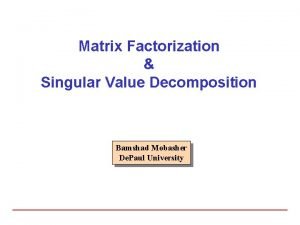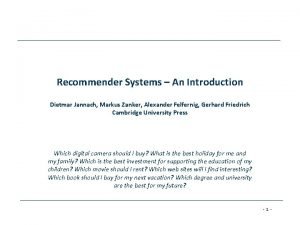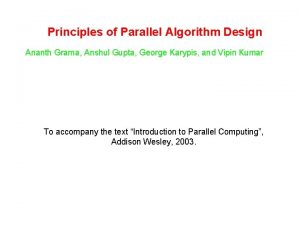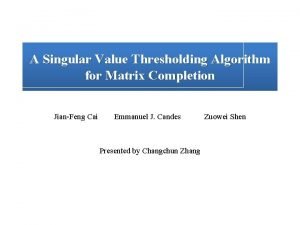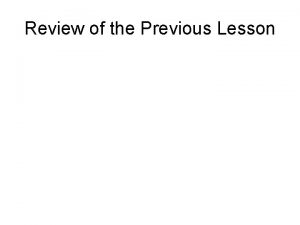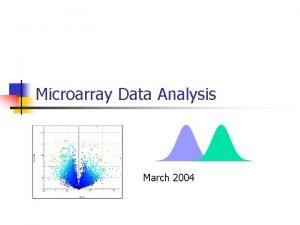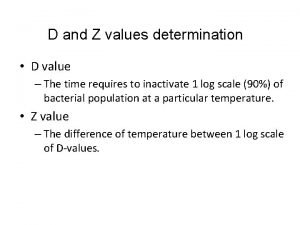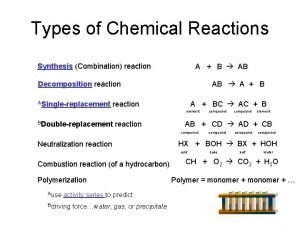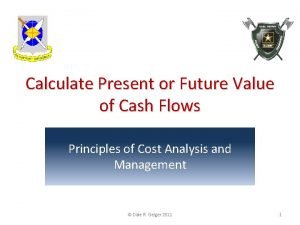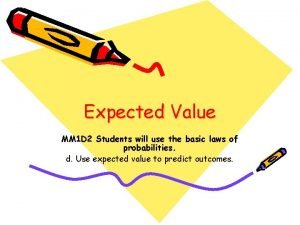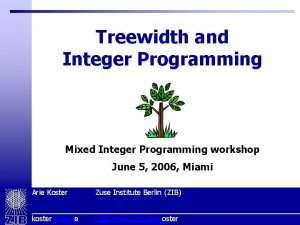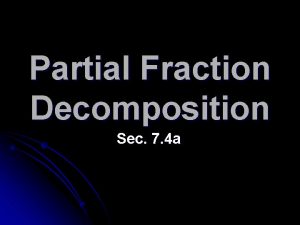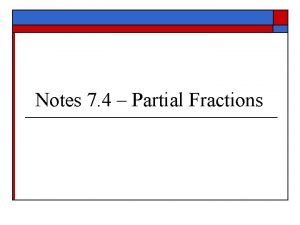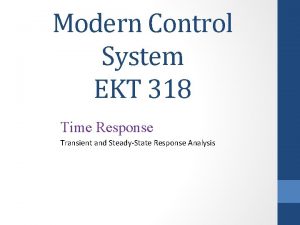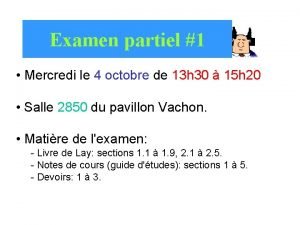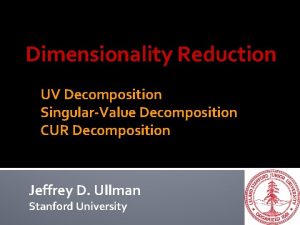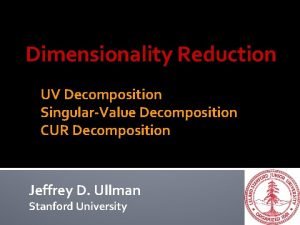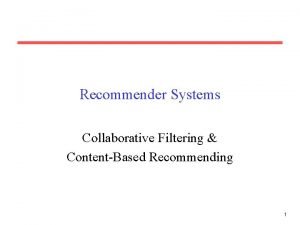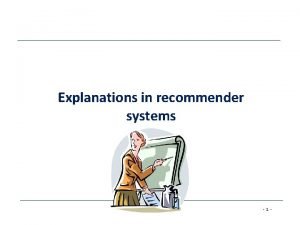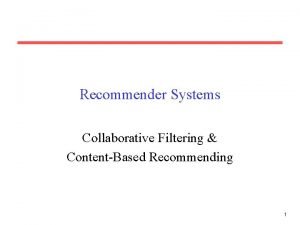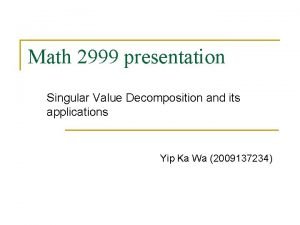Singular Value Decomposition and Application to Recommender Systems
































































- Slides: 64

Singular Value Decomposition, and Application to Recommender Systems CSE 4309 – Machine Learning Vassilis Athitsos Computer Science and Engineering Department University of Texas at Arlington 1

Recommendation Systems – Netflix Version • 2

The Netflix Prize • Back in 2006, Netflix announced a $1 million prize for the first team to produce a recommendation algorithm whose accuracy exceeded a certain threshold. • To help researchers, Netflix made available a large training set from its user data: – 470, 189 users. – 17, 770 movies. – About 100 million ratings. • The prize was finally claimed in 2009. 3

Recommendation Systems – Amazon Version • 4

Recommendation Systems – Amazon Version 2 (No Ratings) • 5

A Disclaimer • There are many different ways in which these recommendation problems can be defined and solved. • Our goal in this class is to understand some basic methods. • The way that actual companies define and solve these problems is usually more complicated. 6

Modeling Ratings • 7

Movie 9 Movie 8 Movie 7 Movie 6 Movie 5 Movie 4 Movie 3 User 1 User 2 User 3 User 4 User 5 User 6 User 7 Movie 2 Movie 1 Modeling Ratings – An Example • 8

Movie 9 Movie 8 Movie 7 Movie 6 Movie 5 Movie 4 Movie 3 User 1 User 2 User 3 User 4 User 5 User 6 User 7 Movie 2 Movie 1 Modeling Ratings – An Example • How can we make any predictions? – If a user has not watched a movie, how can we estimate how much the user would be interested? 9

Movie 9 Movie 8 Movie 7 Movie 6 Movie 5 Movie 4 Movie 3 User 1 User 2 User 3 User 4 User 5 User 6 User 7 Movie 2 Movie 1 Modeling Ratings – An Example • Each user prefers specific movies with specific characteristics. • Each movie has certain characteristics. • If we knew what characteristics each user likes, and what characteristics each movie has, we would have enough information to make predictions. • However, we know neither what each user likes, nor what the characteristics of the movies are. 10

Movie 9 Movie 8 Movie 7 Movie 6 Movie 5 Movie 4 Movie 3 User 1 User 2 User 3 User 4 User 5 User 6 User 7 Movie 2 Movie 1 Modeling Ratings – An Example • There is another source of information. • Some users have similar preferences. – For example, User 2 and User 7 agree on 8 of the nine values. • Intuitively, some users like similar things in movies. We may not know what the users like, but we can tell they like similar things. 11

Movie 9 Movie 8 Movie 7 Movie 6 Movie 5 Movie 4 Movie 3 User 1 User 2 User 3 User 4 User 5 User 6 User 7 Movie 2 Movie 1 Modeling Ratings – An Example • Similarly, some movies have similar scores. – For example, Movie 1 and Movie 5 agree in six of their seven scores. • So, some movies have things in common. We may not know what those things are, but we can tell that there are similarities. 12

Singular Value Decomposition • 13

Movie 9 Movie 8 Movie 7 Movie 6 Movie 5 Movie 4 Movie 3 Movie 2 Movie 1 User 1 User 2 User 3 User 4 User 5 User 6 User 7 14

15

Modeling Users and Movies • SVD gives us a way to model users and movies. – A user is a vector. – A movie is a vector. – The score corresponding to a user and a movie is the weighted dot product of these vectors. • The dimensions are ordered in decreasing order of importance. – The first dimension of the user vectors and the movie vectors is the most important for predicting the user/movie score. – Each next dimension becomes less important. • This is similar to PCA projections, where dimensions are also ordered in decreasing order of importance. 16

Making Predictions • How can we use SVD to guess the score for a user/movie pair? • This is similar to predicting missing values using PCA. – Using all eigenvectors, backprojection just produces the original input. – Using the top few eigenvectors, the backprojection provides a reasonable guess for the hidden pixels. – Why? Because the backprojection formula assumes that the missing data follows the statistical patterns of the training data. Occluded bottom half (input to PCA). Backprojection using 10 top eigenvectors. Backprojection using all eigenvectors. 17

Making Predictions • Occluded bottom half (input to PCA). Backprojection using 10 top eigenvectors. Backprojection using all eigenvectors. 18

Making Predictions • Occluded bottom half (input to PCA). Backprojection using 10 top eigenvectors. Backprojection using all eigenvectors. 19

Making Predictions • Occluded bottom half (input to PCA). Backprojection using 10 top eigenvectors. Backprojection using all eigenvectors. 20

Movie 9 Movie 8 Movie 7 Movie 6 Movie 5 Movie 4 Movie 3 Movie 2 Movie 1 Full. Dimensional SVD User 1 User 2 User 3 User 4 User 5 User 6 User 7 21

Movie 9 Movie 8 Movie 7 Movie 6 Movie 5 Movie 4 Movie 3 Movie 2 Movie 1 User 1 User 2 User 3 User 4 User 5 User 6 User 7 22

• Movie 9 Movie 8 Movie 7 Movie 6 Movie 5 Movie 4 Movie 3 Movie 2 Movie 1 23 User 1 User 2 User 3 User 4 User 5 User 6 User 7

Movie 9 Movie 8 Movie 7 Movie 6 Movie 5 Movie 4 Movie 3 Training Matrix User 1 User 2 User 3 User 4 User 5 User 6 User 7 Movie 2 Movie 1 • Thus, we get a training matrix data, where the values we hide are set to 0. • These are movies that we know that the user watched. • If SVD learned something reasonable, it should predict a high score for those values. 24

• Movie 9 Movie 8 Movie 7 Movie 6 Movie 5 Movie 4 Movie 3 Movie 2 Movie 1 Training Matrix User 1 User 2 User 3 User 4 User 5 User 6 User 7 25

Movie 9 Movie 8 Movie 7 Movie 6 Movie 5 Movie 4 Movie 3 Movie 2 Colors: • Red: hidden values • Green: 1 in training matrix. • Rest: 0 in training matrix Movie 1 Training Matrix User 1 User 2 User 3 User 4 User 5 User 6 User 7 26

Movie 9 Movie 8 Movie 7 Movie 6 Movie 5 Movie 4 Movie 3 Movie 2 Movie 1 Training Matrix User 1 User 2 User 3 User 4 User 5 User 6 User 7 27

Movie 9 Movie 8 Movie 7 Movie 6 Movie 5 Movie 4 Movie 3 Movie 2 Movie 1 Training Matrix User 1 User 2 User 3 User 4 User 5 User 6 User 7 28

Movie 9 Movie 8 Movie 7 Movie 6 Movie 5 Movie 4 Movie 3 Movie 2 Movie 1 Training Matrix User 1 User 2 User 3 User 4 User 5 User 6 User 7 29

Movie 9 Movie 8 Movie 7 Movie 6 Movie 5 Movie 4 Movie 3 Movie 2 Movie 1 Training Matrix User 1 User 2 User 3 User 4 User 5 User 6 User 7 30

Movie 9 Movie 8 Movie 7 Movie 6 Movie 5 Movie 4 Movie 3 Movie 2 • Movies 6 and 9 to User 5. • Movie 7 to User 6. • Movie 6 to User 7. 3 out of the 4 recommendations are movies that these users did watch (and SVD did not know). Movie 1 Training Matrix We would recommend: User 1 User 2 User 3 User 4 User 5 User 6 User 7 31

Computing SVD • 32

Computing SVD • 33

The Movie. Lens Dataset • The Netflix dataset is not publicly available anymore. • The Movie. Lens dataset is a similar dataset that is publicly available. • It has: – 20 million movie ratings. – 138, 000 users. – 27, 000 movies. • There is a "small" version of that dataset, with: – 100, 000 movie ratings. – 700 users. – 9, 000 movies. 34

Trying SVD on Movie. Lens • We will use the "small" Movie. Lens dataset to repeat the experiment we did before with our toy example. • We convert the ratings matrix to a binary (0/1) matrix. – – 0 stands for "user did not watch movie". 1 stands for "user watched movie". 98. 4% of the binary matrix values are equal to 0. 1. 6% of the binary matrix values are equal to 1. • We want to use SVD to recommend movies to users. • How can we test how well SVD works? 35

Trying SVD on Movie. Lens • We create a training matrix, by randomly choosing half of the 1 values, and "hiding" them (setting them to 0). • These hidden values are 0 in the training data, but we know that users actually watched those movies. – We can assume that users were interested in those movies, and it would have been a good idea to recommend those movies to those users. • If SVD gives high scores to those movies, it means that it has learned a good model for making movie recommendations. 36

Issues with Evaluating Accuracy • In general, evaluating prediction accuracy is a nontrivial task. – This is an issue in general classification tasks as well. – This is simply our first encounter with some of the complexities that arise. • Oftentimes people do not understand the underlying issues, and report numbers that are impressive, but meaningless. 37

Issues with Evaluating Accuracy • For example: consider the Movielens. • Suppose we build a model that says that each user is not interested in any movie that is not marked as "watched" in the training data. • How accurate is that model? – How do we evaluate that accuracy? • Intuitively, we know that such a model is pretty useless. • We know for a fact that some zeros in the training matrix were corresponding to "hidden" ones. • How can we capture quantitatively the fact that the model is very bad? 38

Issues with Evaluating Accuracy • 39

Issues with Evaluating Accuracy • 40

Issues with Evaluating Accuracy • Going back to the Movie. Lens dataset: • Once we get predictions of ones and zeros, we can compare them against the ones and zeros of the true data matrix. – In the true data matrix the "hidden" ones show as actual ones. • In measuring accuracy, we will exclude the positions where the training matrix contains "1" values. – The goal is to use the predictions to recommend movies. – If we have a "1" in the training matrix, we know that the user watched that movie, so there is no point in recommending that movie to that user. 41

Issues with Evaluating Accuracy • 42

Issues with Evaluating Accuracy • 43

Issues with Evaluating Accuracy • One issue is that the classes are asymetrically distributed. • There are way more "0" values than "1" values. • Many machine learning problems are like that. • Another example: face detection in images. – In many datasets, more than 99. 9% of image windows are NOT faces. – A face detector that never detects any faces is 99. 9% accurate. • Another issue is that the final prediction depends on an arbitrary threshold. 44

Balanced Accuracy Rate • 45

Precision vs. Recall • 46

Precision vs. Recall • Suppose that we have two methods, A and B. • Suppose that each of these methods uses a threshold to produce the final results. • Classic mistake #2: – "Method A achieved a precision of 90% and a recall of 80%". – "Method B achieved a precision of 92% and a recall of 60%". • If the results of A and B depend on thresholds, you should never report results using a single threshold. • Instead, you should show a precision vs. recall plot. 47

Precision vs. Recall • 48

Choosing a Threshold • The choice of threshold makes a big difference. • A low threshold leads to: – A higher number of total recommendations. – Consequently, higher recall (higher number of correct items are recommended). – A smaller percentage of correct recommendations among the recommendations that are made. – Consequently, lower precision. 49

Choosing a Threshold • The choice of threshold makes a big difference. • A high threshold leads to: – A lower number of total recommendations. – Consequently, lower recall (lower number of correct items are recommended). – A larger percentage of correct recommendations among the recommendations that are made. – Consequently, higher precision. 50

Choosing a Threshold • Each point on the curve represents a trade-off between precision and recall. • For example, one point gives: – precision 10. 1%. – recall 67. 3%. • Another point corresponds to: – precision 59. 0%. – recall 9. 9%. • Another point corresponds to: – precision 84. 7%. – recall 1. 1%. 51

Choosing a Threshold • 52

Choosing a Threshold • 53

Choosing a Threshold • 54

Choosing a Threshold • So, we have many choices, some of which are: – 497 suggestions/user, 50 of those are correct. – 12. 5 suggestions/user, 7. 4 of those are correct. – 0. 97 suggestions/user, 0. 82 of those are correct. • Which of those choices would you prefer as a user? – I would personally prefer the middle option, 7. 4 correct suggestions out of 12. 5 suggestions. – 0. 97 suggestions per user is too small. – 50 correct recommendations out of 497 is also too small. 55

The Sparsity of Ratings • 56

The Sparsity of Ratings • As another example, Amazon has millions of users, and sells tens to hundreds of millions of products. • It is hard to imagine that any user has bought more than a very small fraction of all available products. • So, for the rest of the products, the system does not really know if the user is interested in them or not. 57

Dealing with Sparse Data • In our Movie. Lens example, we represented missing data with 0 values. – Our training matrix had 0 values for all (user, movie) pairs where the user did not watch that movie. • However, our goal is not to figure out which movies the user has watched. – Our goal is to figure out which movies the user may want to watch. • Therefore, instead of representing not-watched movies with 0 values, we can treat those values as missing data. 58

SVD with Missing Data • 59

Using Averages for Missing Values • 60

Iterative SVD • 61

Iterative SVD • 62

SVD Recap • SVD is a mathematical method that factorizes a matrix into a product of three matrices with specific constraints. • This factorization is useful in recommendation systems: – One matrix represents users. – One matrix represents products. – User/product scores are represented as weighted dot products between user vectors and product vectors. • The training data usually contains lots of missing values. • To use SVD, we need to first fill in those values somehow (for example, by looking at average scores given by a user, and average scores received by a product). • Iterative SVD allows us to update our estimate of the missing values, using previous invocations of SVD. 63

Recommendation Systems • We have looked at a very simple solution for recommendation systems, using SVD. • Much more sophisticated (and accurate) methods are available. • For more information, you can search on the Web for things like: – Netflix prize. – Recommendation systems. 64
 Singular value decomposition for recommendation systems
Singular value decomposition for recommendation systems Singular value decomposition
Singular value decomposition Singular value decomposition
Singular value decomposition Singular value decomposition image compression
Singular value decomposition image compression Matrix factorization
Matrix factorization Introduction to recommender systems
Introduction to recommender systems Recommender systems an introduction
Recommender systems an introduction Weighted hybrid recommender systems
Weighted hybrid recommender systems Sgd vs gd
Sgd vs gd Recommender relationship
Recommender relationship Earned value management systems application guide
Earned value management systems application guide Penciptaan nilai adalah
Penciptaan nilai adalah A singular subject takes a singular verb examples
A singular subject takes a singular verb examples Simple application of exploratory decomposition
Simple application of exploratory decomposition A simple application of exploratory decomposition is
A simple application of exploratory decomposition is A simple application of exploratory decomposition is_
A simple application of exploratory decomposition is_ Singular value thresholding
Singular value thresholding Value received and value parted with
Value received and value parted with Pvalue formula
Pvalue formula D value and z value
D value and z value Acid value principle
Acid value principle Value creation vs value capture
Value creation vs value capture Decision support systems and intelligent systems
Decision support systems and intelligent systems Query decomposition in dbms
Query decomposition in dbms Decomposition zulfikar ghose
Decomposition zulfikar ghose Examples for chemical combination reaction
Examples for chemical combination reaction The area of polygons through composition and decomposition
The area of polygons through composition and decomposition Future value of $1
Future value of $1 Relative value vs absolute value
Relative value vs absolute value What is the value of what is the value of
What is the value of what is the value of What is the value of what is the value of
What is the value of what is the value of Anthropocentrism examples
Anthropocentrism examples Ndia evms intent guide
Ndia evms intent guide Environmental value system
Environmental value system Environmental value systems diagram
Environmental value systems diagram Environmental value system
Environmental value system Earned value analysis microsoft project
Earned value analysis microsoft project Engineering elegant systems: theory of systems engineering
Engineering elegant systems: theory of systems engineering Embedded systems vs cyber physical systems
Embedded systems vs cyber physical systems Elegant systems
Elegant systems Exact cell decomposition
Exact cell decomposition Naclo3 decomposition
Naclo3 decomposition Short method truth table
Short method truth table Tree decomposition
Tree decomposition Tree decomposition
Tree decomposition Ways nitrogen can be fixed
Ways nitrogen can be fixed Combustion reaction cartoon examples
Combustion reaction cartoon examples Lu decomposition for tridiagonal matrix
Lu decomposition for tridiagonal matrix Decomposition of organic matter equation
Decomposition of organic matter equation Dekomposisi lu 3x3
Dekomposisi lu 3x3 Expand the quotient by partial fractions.
Expand the quotient by partial fractions. Speculative decomposition
Speculative decomposition Partial fraction method
Partial fraction method Partial fraction decomposition emath
Partial fraction decomposition emath Logical decomposition
Logical decomposition Spinodal decomposition
Spinodal decomposition Lu decomposition method
Lu decomposition method Ba(no3)2 decomposition
Ba(no3)2 decomposition Thermal stability of group 2 nitrates
Thermal stability of group 2 nitrates Functional decomposition diagram
Functional decomposition diagram Reynolds decomposition
Reynolds decomposition Expander decomposition
Expander decomposition Décomposition lu
Décomposition lu Combustion reaction
Combustion reaction Modular decomposition in software engineering
Modular decomposition in software engineering




